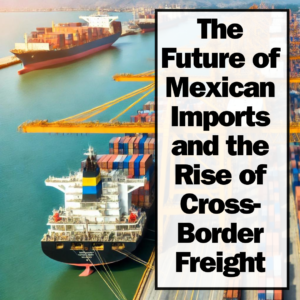
The future of Mexican imports into the U.S. is set to experience significant growth and transformation. Several factors are driving this trend, including changes in global supply chains, trade agreements, and strategic business expansions. Here’s a detailed look at the future of Mexican imports and the growing cross-border freight industry.
Shifting Supply Chains and Increased Imports
As global supply chains continue to evolve, Mexico is becoming an increasingly important hub for imports into the U.S. The ongoing diversification of shipping routes by Chinese manufacturers, aiming to avoid tariffs and trade restrictions, is a major contributor. By routing goods through Mexico, these companies can leverage the benefits of the USMCA and create more resilient supply chains. A recent report highlighted a 60% increase in container shipping imports from China to Mexico in early 2024, reflecting this strategic shift.
Booming Manufacturing Sector
Mexico’s manufacturing sector is booming, driven by significant foreign investments, particularly from Chinese companies. These investments are leading to the establishment of new assembly plants and factories, further boosting the volume of goods being imported into the U.S. through Mexico. This trend is expected to continue as more companies recognize the strategic advantages of manufacturing and exporting from Mexico.
Expansion of American Trucking Companies
American trucking companies are expanding their cross-border operations to capitalize on the increasing demand for efficient logistics solutions. Companies like XPO Logistics, Saia, and various cross-border logistics firms are enhancing their services to improve capacity, technology, and operational efficiency for cross-border freight.
XPO Logistics: XPO has launched its new cross-border service, “Mexico Plus,” which focuses on increasing capacity and leveraging advanced technology to streamline operations. This service aims to provide seamless logistics solutions for businesses engaged in cross-border trade.
Freight Expansion: Many cross-border logistics firms are expanding their operations into Mexico, recognizing the growing need for robust logistics solutions. This expansion includes setting up new facilities, enhancing transportation networks, and integrating advanced technologies to handle the increased volume of goods.
Saia’s Partnership: Saia, a prominent LTL (less-than-truckload) carrier, has entered into a partnership with Fletes Mexico to enhance its cross-border services. This partnership aims to provide customers with improved service and greater efficiency in managing cross-border shipments.
The Future Landscape
The future of cross-border freight between the U.S. and Mexico looks promising, driven by several key factors:
Technological Advancements: The integration of advanced technologies, such as real-time tracking, automated processes, and AI-driven logistics management, will enhance the efficiency and reliability of cross-border freight services.
Infrastructure Development: Continued investment in infrastructure, including ports, highways, and logistics facilities, will support the growing volume of cross-border trade. Improvements in infrastructure will reduce transit times and enhance the overall supply chain.
Regulatory Support: The USMCA provides a favorable regulatory framework that encourages cross-border trade. Continued support from regulatory bodies will ensure that the trade relationship between the U.S. and Mexico remains strong and mutually beneficial.
Sustainability Initiatives: As environmental concerns grow, both countries are likely to implement more sustainable practices in their logistics operations. This includes the adoption of greener technologies and practices to reduce the carbon footprint of cross-border freight.
Conclusion
The future of Mexican imports and cross-border freight is set to be dynamic and growth-oriented. With strategic expansions by American trucking companies, increased manufacturing activity in Mexico, and supportive trade agreements, the cross-border logistics landscape will continue to evolve. Businesses engaged in cross-border trade can look forward to enhanced services, improved efficiency, and greater opportunities in this thriving sector.
For more insights and updates on cross-border freight, stay tuned to the latest developments in the logistics industry.












